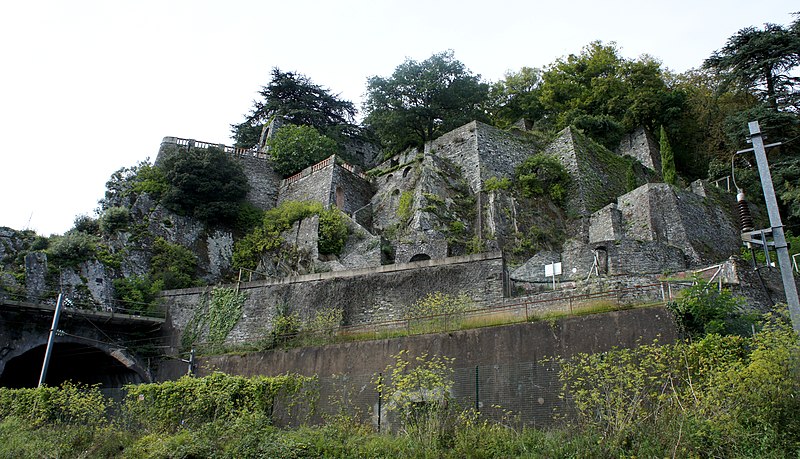
Owning a house on the banks of the river Loire in France may mean you can enjoy magnificent views of the river. And if your property has high rocks in its backyard, it is understandable to create a viewpoint uphill, to enjoy an even more splendid view.
But why create a multitude of terraces, supported by high walls, connected by stairs and paths, and equiped with various smaller constructs, as the owner of this location did.... The local archives have no answer, but Siffait, who made these constructs, may have had that Babylonian drive that characterises so many of the autodidact builders featured in this documentary blog.
Indeed, this site, embellished with creative constructs by its nonprofessional owner, can be seen as an outsider environment, like those, who focus upon its curious architecture, might denote it as a folly.
Indeed, this site, embellished with creative constructs by its nonprofessional owner, can be seen as an outsider environment, like those, who focus upon its curious architecture, might denote it as a folly.
Life and works.
Born in Abbeville, in northern France, Maximilien Siffait (ca.1780-1861), as a young man served Napoleon in his Italian and Egyptian campaigns, and then got a job at the french customs, where he quickly made career, to become chief tax-collector.
In 1815, on a business trip in the area of the Atlantic coast, he became charmed by the beauty of the basin of the river Loire near Nantes and decided to settle there with his wife whom he had married in 1806.
The couple bought the Gérardière manor with associated grounds, located along the Loire, in the small community of Le Cellier.
Rather soon, probably around 1817 *, Siffait began the construction project. Since he left Le Cellier in 1830, he at most had fourteen years to realize the walls, terraces, balustrades, towers, stairs, pathes (some leading nowhere) , trompe-l'oeil's and additional structures, such as kiosks, chapels, a grotto and an amphitheatre.
The archives of the community have no documents with regard to the way the constructs have been realized.
Siffait may have employed assistants too help him, what is probable, not only because of the size of the works, but also because, having been elected mayor in 1922, he may have wanted to realize employment for the impoverished population of the region
Stone material undoubtedly was available on the spot, but how Siffait financed payment of eventual employees?..... it hasn't been documented.
Next map gives an impression of the size of the site:

___________
note
* with regard to the date Siffait begun his constructs I am following the article on the Le Cellier website, where it is said Siffait was active in making constructs between 1817 and 1829; other sources say Siffait began around 1826
Maximilien Siffait
this picture and the next two courtesy
of Rita & Pieter Boogaart
of Rita & Pieter Boogaart
Stone material undoubtedly was available on the spot, but how Siffait financed payment of eventual employees?..... it hasn't been documented.

Siffait's private life had some tragic moments. The couple had three children, one of these, a daughter, died when very young, in 1819 his wife died, and in 1830 his other daughter also died, 18 years old.
In 1830 his mayorship ended and the same year Siffait left the community, going to live somewhere else.
Site transformed into a park
Siffait's son Oswald, in 1836 went to live in the Gérardière manor. Married in 1838, in 1840 he began transforming the site into a park by planting a varied collection of trees.
Around the same time the railway connection between Angers and Nantes along the Loire was projected and despite local protests against its trace on the river's right bank, this route was realised, separating the property from the river.
In later years the family moved to Nantes, and although the manor remained in their possession, from around 1870 on, the site fell into oblivion.
Restoration
In the eighties of the former century interest in the site revived, also because of activities of the Nantes school of architecture. In 1986 the community of Le Cellier acquired the property (in 2007 the department became its owner). Plans for restoration have been developped and protective measures have been taken.
Documentation
* Article on the website of the community of Le Cellier (in french), with bibliography
* More pictures on Flickr, Le Cellier group pool
* Website of the department Loire-Atlantique with a video (2'57") about the constructs (french spoken)
* More pictures on Flickr, Le Cellier group pool
* Website of the department Loire-Atlantique with a video (2'57") about the constructs (french spoken)
___________
note
* with regard to the date Siffait begun his constructs I am following the article on the Le Cellier website, where it is said Siffait was active in making constructs between 1817 and 1829; other sources say Siffait began around 1826
Maximilien Siffait
Folies Siffait
Saint Méen
44850 Le Cellier, F
large parts of the site have been fenced
because of possible dangerous situations;
some safe parts may be visitable
organised public visits at the occasion of
because of possible dangerous situations;
some safe parts may be visitable
organised public visits at the occasion of
the Heritage days, third weekend of september
Folies Siffait weergeven op een grotere kaart






Tidak ada komentar:
Posting Komentar